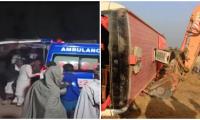LAHORE: Accessibility audit of NA-154 polling stations showed distressing statistics as it appeared that 73 percent of the sampled polling stations didn’t meet the essential accessibility criteria.
This implies that persons with disabilities, elderly and the sick will not be able to make it to 73 percent of the polling stations on February 12, 2018 by-election in Lodhran-I.
The report was issued by Pakistan Alliance for Inclusive Elections (PAIE) to share findings of Accessibility Audit of polling stations in NA-154. The exercise is conducted before election day to gauge the opportunities available for persons with disabilities to access polling stations on voting day. A trained team of observers visited polling stations that were selected by a scientifically drawn sample.
According to a press release issued here Friday, the team started assessing the approach to the polling station building; statistics reveal that 17 percent polling stations do not have a firm and obstacle-free passage leading to the building. The 25 percent buildings do not provide a level access to the entrance of polling station and out of these, 92 percent buildings do not possess a ramp to facilitate wheelchair users in entering the polling stations. Observers also witnessed that in 23 percent cases protruding objects were reported outside the polling stations, causing obstacle on the way.
Entrance gates of all sampled polling stations are wider than minimum standard of 32 inches, but as witnessed by credible and experienced auditors of PAIE, usually the smaller gates remain open on election day instead of these larger gates. The larger gates are intentionally closed for legitimate reasons i.e. security and to avoid overcrowding in the polling stations. But the smaller gates possess multiple problems; first, the lesser opening width than minimum standard of 32 inches; second, the iron bar at lower edge of the metal gates that is always thicker than maximum door threshold standard of 6mm, third, the lower edge bar of the gates is generally two to three inches higher than ground causing another obstacle. All these points make it difficult for special persons and the elderly to enter polling stations thus making it inaccessible. If staff does not open larger gates for them on election day then 100 percent polling stations naturally become inaccessible for them. The ECP should make the polling stations precisely more accessible and should be mindful of these minute hurdles. The survey further revealed that the interior building and outer entrance of 65 percent polling stations were not on same level and only 10 percent ramps were reported in set sample size, no other facilities existed to facilitate the movement of special persons.
The study signified that even if the special persons and the elderly cross the main gate of the building 65 percent polling station buildings will still pose challenge and they will have to cross stairs to reach the polling area.
Availability of the light being one of the significant conditions of accessibility criteria, it was reported that only 17 percent of the polling stations possess exterior lighting arrangement, leaving 83 percent sampled polling station entrance unlit at the time of low visibility.
A police tape.— APP/file The Emergency Services Departmentresponded to 1,149 road accidents in all districts of...
Martyr Constable Shafique Ahmed.— Punjab Police website/File LAHORE: A house worth Rs13.5million has been provided...
An event organised by the Lodhran Pilot Project.— Facebook@LodhranPilotProject/File LAHORE: In an era where...
Tourists seen amid tour of the Bhatti Gate by the Walled City of Lahore Authority on December 29. 2024.—...
Pakistan Furniture Council Chief Executive Officer Mian Kashif Ashfaq. — APP/FileLAHORE: The Pakistan Furniture...
A representational image of tea bags.— Reuters/File LAHORE: Health experts have warned that microplastics present in...







